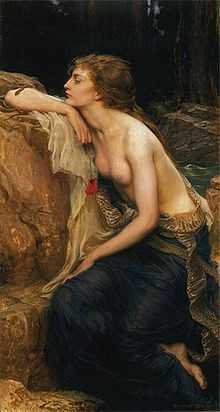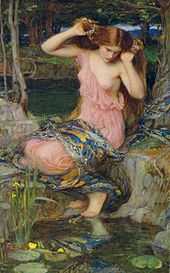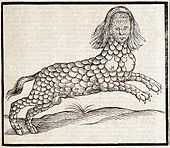Lamia
 The Lamia: In this 1909 painting by Herbert James Draper, Lamia has human legs and a snakeskin around her waist. There is also a small snake on her right forearm. | |
| Grouping | Legendary creature |
|---|---|
| Sub grouping | Daemon |
| Similar creatures |
Empusa, Mormo |
| Mythology | Greek |
| Country | Born in Libya but roams throughout Europe |
In ancient Greek mythology, Lamia (/ˈleɪmiə/; Greek: Λάμια) was a beautiful queen of Libya who became a child-eating daemon. Aristophanes claimed her name derived from the Greek word for gullet (λαιμός; laimos), referring to her habit of devouring children.[1]
In the myth, Lamia is a mistress of the god Zeus, causing Zeus' jealous wife, Hera, to kill all of Lamia's children (except for Scylla, who is herself cursed) and transform her into a monster that hunts and devours the children of others. Another version has Hera merely stealing away all of Lamia's children and it being Lamia herself, losing her mind from grief and despair, who starts stealing and devouring others' children out of envy, the repeated monstrosity of which transforms her into a monster on its own.
Some accounts say she has a serpent's tail below the waist.[2] This popular description of her is largely due to Lamia, a poem by John Keats composed in 1819.[3] Antoninus Liberalis uses Lamia as an alternate name for the serpentine drakaina Sybaris; however, Diodorus Siculus describes her as having nothing more than a distorted face.[4]
Later traditions referred to many lamiae; these were folkloric monsters similar to vampires and succubi that seduced young men and then fed on their blood.[5]
In later stories, Lamia was cursed with the inability to close her eyes so that she would always obsess over the image of her dead children. Some accounts (see Horace, below) say Hera forced Lamia to devour her own children. Myths variously describe Lamia's monstrous (occasionally serpentine) appearance as a result of either Hera's wrath, the pain of grief, the madness that drove her to murder, or—in some rare versions—a natural result of being Hecate's daughter.[6]
Zeus then gave her the ability to remove her eyes. The purpose of this ability is unclear in Diodorus, but other versions state Lamia's ability to remove her eyes came with the gift of prophecy. Zeus did this to appease Lamia in her grief over the loss of her children and to let her rest since she could not close her eyes.[7]
Horace, in Ars Poetica (l.340) imagines the impossibility of retrieving the living children she has eaten:
Neu pranse Lamiae vivum puerum extrabat alvo.
Alexander Pope translates the line:
Shall Lamia in our sight her sons devour,and give them back alive the self-same hour?
Stesichorus identifies Lamia as a daughter of Poseidon and as the mother of Scylla by Phorcys.[8] This might be a conflation of Lamia with the sea goddess Ceto, traditionally Phorcys's wife and mother of Scylla. Further passing references to Lamia were made by Strabo (i.II.8) and Aristotle (Ethics vii.5). Other sources cite Triton as having fathered Scylla by Lamia. Antoninus Liberalis identifies the dragon Sybaris with Lamia, another conflation.
Interpretations

Mothers throughout Europe used to threaten their children with the story of Lamia.[9] Leinweber states, "She became a kind of fairy-tale figure, used by mothers and nannies to induce good behavior among children."[10]
Many lurid details were conjured up by later writers, assembled in the Suda, expanded upon in Renaissance poetry and collected in Bulfinch and in Brewer's Dictionary of Phrase and Fable: Lamia was envious of other mothers and ate their children. She was usually female, but Aristophanes suggests a hermaphroditic phallus, perhaps simply for monstrosity's sake.[11] Leinweber notes, "By the time of Apuleius, not only were Lamia characteristics liberally mixed into popular notions of sorcery, but at some level the very names were interchangeable."[12] Nicolas K. Kiessling compared the lamia with the medieval succubus and Grendel in Beowulf.[13]
Apuleius, in The Golden Ass, describes the witch Meroe and her sister as lamiae:[14] "The three major enchantresses of the novel — Meroe, Panthia and Pamphylia — also reveal many vampiric qualities generally associated with Lamiae," David Walter Leinweber has noticed.[15]

One interpretation posits the Lamia may have been a seductress, as in Philostratus' Life of Apollonius of Tyana, where the philosopher Apollonius reveals to the young bridegroom, Menippus, his hastily-married wife is really a lamia, planning to devour him.[16] Some harlots were named "Lamia".[17] The connection between Demetrius Poliorcetes and the courtesan Lamia was notorious.[18][19][20] In the painting by Herbert James Draper (1909, illustration above), the Lamia who moodily watches the serpent on her forearm appears to represent a hetaera. Although the lower body of Draper's Lamia is human, he alludes to her serpentine history by draping a shed snake skin about her waist. In Renaissance emblems, Lamia has the body of a serpent and the breasts and head of a woman, like the image of hypocrisy.[citation needed]
Christian writers warned against the seductive potential of lamiae. In his 9th-century treatise on divorce, Hincmar, archbishop of Reims, listed lamiae among the supernatural dangers that threatened marriages, and identified them with geniciales feminae,[21] female reproductive spirits.[22]
John Keats described the Lamia in Lamia and Other Poems, presenting a description of the various colors of Lamia that was based on Burton's in The Anatomy of Melancholy.[23] The Keats story follows the general plotline of Philostratus, with Apollonius revealing Lamia's true nature before her wedding.

Modern folk traditions
In the modern Greek folk tradition, the Lamia has survived and retained many of her traditional attributes.[24] John Cuthbert Lawson remarks "....the chief characteristics of the Lamiae, apart from their thirst for blood, are their uncleanliness, their gluttony, and their stupidity".[25] The contemporary Greek proverb, "της Λάμιας τα σαρώματα" ("the Lamia's sweeping"), epitomises slovenliness[citation needed]; and the common expression, "τό παιδί τό 'πνιξε η Λάμια" ("the child has been strangled by the Lamia"), explains the sudden death of young children.[25]
In popular culture
The English poet John Keats pulished his narrative poem "Lamia" in 1820.[26] The poem has influenced later works of Western literature. Elizabeth Barrett Browning's epic poem "Aurora Leigh" contains numerous references to Lamia, including Book One in which at times a portrait of her dead mother appears as a Lamia, and Book Six in which she repeatedly refers to Lady Waldemar as Lamia. Booker Prize winner A.S. Byatt's 1998 collection of short fiction, Elementals: Stories of Fire and Ice contains a short story entitled "A Lamia in the Cévennes", which references Keats poem.[27] The character Brawne Lamia appears in Dan Simmons' novels Hyperion and The Fall of Hyperion. The works of John Keats feature heavily in the novels.[28][29] In Neil Gaiman's novel Neverwhere, Lamia is a "velvet," a type of warmth-drinking vampire.
Keats's poem also influenced British progressive-rock band Genesis and their track "The Lamia" from the 1974 double concept album The Lamb Lies Down on Broadway. The lyrics to the track, written by then lead vocalist Peter Gabriel, describe three snakelike creatures with female faces, roughly corresponding to Diodorus's description.
The lamia has appeared as a monster in the Dungeons & Dragons fantasy role-playing game, introduced to D&D in the first edition of Advanced Dungeons & Dragons (1977), with an illustration by David C. Sutherland III,[30] after the edition moved away from a theme of 1960s and 1970s "sword and sorcery" fantasy fiction to a mixture of medieval history and mythology.[31] Lamia have also appeared in other roleplaying games inspired by Dungeons & Dragons, such as Pathfinder.[32]
Lamia has also appeared in Rick Riordan's book, The Demigod Diaries. Lamia was disguised as an event choreographer for Dr. Claymore, a famous author. When Claymore discovers a child of Hecate that Lamia targeted, she destroys Claymore's laptop that contained his writing works. She also destroys his favorite coffeeshop and the owner, Burly Black. Claymore escapes and warns the child about Lamia's coming. But Lamia tracks them down and eventually holds Claymore at her mercy, right after the duo find a way to banish Lamia and bind her to the earth. Claymore dies and arrives at the Temple of Hecate, where Hecate herself explains everything. Claymore then returns to the child and with Lamia being banished, walks away.
A Lamia plays an important role in Gene Wolfe's Soldier of the Mist (1986) - later retitled Latro in the Mist (2003).
In the song "Prodigal Son" from the 1981 Iron Maiden album Killers, the singer directly asks Lamia for help since the devil has got hold of his soul.[33]
The character also makes an appearance in the BBC show Merlin, where she is the primary antagonist of season 4, episode 8, "Lamia". Here she is portrayed as a beautiful girl with serpent's blood who causes discord and violence among the men around her.
Lamias have also appeared in Japanese manga, most notably in Rosario + Vampire (where the mathematics teacher Ririko Kagome is a lamia) and in Monster Musume (where the main character Miia is a lamia). Neither character is portrayed as evil or dangerous.
See also
References
- ↑ Aristophanes, The Wasps, 1177.
- ↑ Compare Typhon (Typhoeus), Echidna, the Gigantes and other archaic chthonic bogeys.
- ↑ Keats, "Lamia"
- ↑ Diodorus Siculus, Library of History xx.41.
- ↑ Information on Lamia from the Online Encyclopedia
- ↑ Odyssey 12.124 and scholia, noted by Karl Kerenyi, Gods of the Greeks 1951:38 note 71.
- ↑ Bell, Women of Classical Mythology, drawing upon Diodorus Siculus 22.41; Suidas 'Lamia'; Plutarch 'On Being a Busy-Body' 2; Scholiast on Aristophanes' Peace 757; Eustathius on Odyssey 1714)
- ↑ Stesichorus Frag 220, Eustathius on Homer's Odyssey 1714.
- ↑ Tertullian, Against Valentinius (ch.iii)
- ↑ Leinweber 1994:77.
- ↑ Aristophanes, Peace, l..758
- ↑ Leinweber 1994:78
- ↑ See Nicolas K. Kiessling, "Grendel: A New Aspect" Modern Philology 65.3 (February 1968):191–201.
- ↑ The Elizabethan translator William Adlington rendered lamiae as "hags", obscuring the reference for generations of readers. ([Apuleius], Metamorphoses [Harvard University Press] 1989 (Metamorphoses is more familiar to English-language readers as The Golden Ass.).
- ↑ Leinweber, "Witchcraft and Lamiae in 'The Golden Ass'" Folklore 105 (1994:77–82).
- ↑ Leinweber 1994:77f
- ↑ Kerényi 1951 p 40.
- ↑ See Plutarch, Life of Demetrius xxv.9
- ↑ See Aelian, Varia Historia XII.xvii.1
- ↑ See Athenaeus, Deipnosophistae III.lix.29.
- ↑ Hincmar, De divortio Lotharii ("On Lothar's divorce"), XV Interrogatio, MGH Concilia 4 Supplementum, 205, as cited by Bernadotte Filotas, Pagan Survivals, Superstitions and Popular Cultures in Early Medieval Pastoral Literature (Pontifical Institute of Mediaeval Studies, 2005, p. 305.
- ↑ In his 1628 Glossarium mediae et infimae latinitatis, Du Cange made note of the geniciales feminae, and associated them with words pertaining to generation and genitalia; entry online.
- ↑ Keats made a note to this effect at the end of the first page in the fair copy he made: see William E. Harrold, "Keats's 'Lamia' and Peacock's 'Rhododaphne'" The Modern Language Review 61.4 (October 1966:579–584) p 579 and note with bibliography on this point.
- ↑ Lamia receives a section in Georgios Megas and Helen Colaclides, Folktales of Greece (Folktales of the World) (University of Chicago Prtes) 1970.
- ↑ 25.0 25.1 Lawson, Modern Greek Folklore and Ancient Greek Religion: A Study in Survivals (Cambridge University Press) 1910:175ff.
- ↑ http://www.bartleby.com/126/36.html Keats's poem Lamia
- ↑ "There’s a Lamia in My Swimming Pool".
- ↑ "El ascenso de Endymion, de Dan Simmons".
- ↑ "Hyperion by Dan Simmons".
- ↑ Gygax, Gary. Monster Manual (TSR, 1977)
- ↑ Cook; Player's Handbook (1989), pp. 25-41
- ↑ James Jacobs, ed. (September 2009). "Monsters A to Z". Bestiary. Pathfinder Roleplaying Game. Lead designer Jason Bulmahn. Paizo Publishing. p. 186. ISBN 978-1-60125-183-1.
- ↑ http://www.metrolyrics.com/prodigal-son-lyrics-iron-maiden.html
Sources
- Graves, R. (1955). "Lamia". Greek Myths. London: Penguin. pp. 205–06. ISBN 0-14-001026-2.
- Karl Kerényi, 1951. The Gods of the Greeks pp 38–40. Edition currently in print is Thames & Hudson reissue, February 1980, ISBN 0-500-27048-1.
External links
| Wikimedia Commons has media related to Lamia (mythology). |